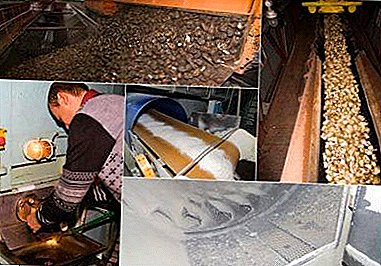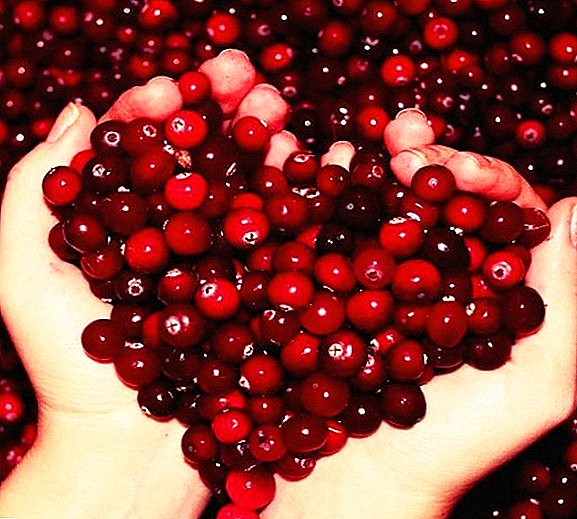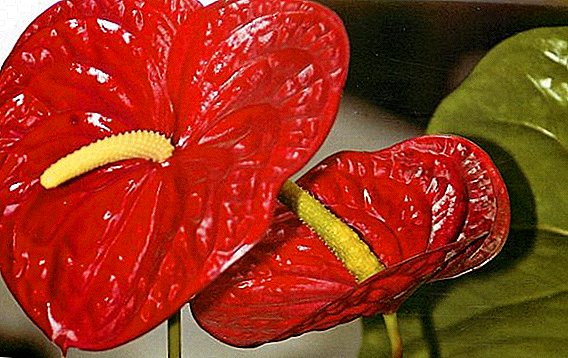 Cucumber "Mamenkin pet" - quite a popular self-pollinating hybrid. Differs in high precocity, is suitable both for greenhouse cultivation, and for cultivation in an open ground.
Cucumber "Mamenkin pet" - quite a popular self-pollinating hybrid. Differs in high precocity, is suitable both for greenhouse cultivation, and for cultivation in an open ground.
Variety description
The first fruits appear after 6 weeks after germination. In the leaf sinuses formed by 3-7 ovaries. The hybrid has a strong (as for cucumbers) root system, which is not subject to rot. Foliage - a characteristic shape, bright green.
The advantages of the variety:
- good taste;
- high yield;
- suitable for various purposes (salads, pickle, pickling, preservation);
- grows well in greenhouses and in the ground;
- does not need bee pollinating.
Fruit characteristics and yield
Cucumbers are small: in length - 8-10 cm, in weight - 90-110 g. The sturdy, hilly fruits have dense skin, spikes of black color and crispy flesh. One bush for the season brings from 6.3 to 7.4 kg of fruit. From 1 square. meters can collect up to 12.8 kg of crop. 
Selection of seedlings
When choosing seedlings carefully inspect the seedlings. A few simple recommendations will help determine the quality of seedlings:
- Get the landing material which age does not exceed 4-4,5 weeks. This can be determined by the number of leaves (4-5 no more) and the height of the shoot (11-14 cm).
- Pay special attention to inspection of the roots. Try to choose plants without dry and broken root processes. On the rhizome must be a piece of wet substrate.
- See that the stem is healthy, without pigmentation, dry grooves, quite strong.
- If the plant has an unnaturally bright color, and its lower leaves are weak and not quite healthy, then most likely the plant has been abused by phytostimulants.
Did you know? The name "cucumber" came to us from Greece, where the word "augros" meant "unripe".
VIDEO: HOW TO VIBRATE THE BEST SPRING
Soil and fertilizer
The best soil for growing cucumbers is clay or loose sand. The recommended acidity is about 7.0 or slightly lower. Acid or alkaline soils are not suitable.
No less important for a good harvest is the right crop rotation. Cucumbers grow poorly after all pumpkin, but they normally take root after root crops and beets. Well, and best of all they feel in places where tomatoes and cabbage grew before them.
Familiarize yourself with the table of vegetable predecessors during planting.
Begin to prepare the land for planting during the autumn gardening works. If the pH of the soil is 6.0 or lower, it is necessary to reduce the acidity. For these purposes, apply:
- lime extinguished;
- calcium carbonate;
- ash;
- alkaline liquid organics;
- dolomitic flour.
 Mix sawdust with such ingredients:
Mix sawdust with such ingredients:- cow milk - 7-10 l;
- ash - 60 g;
- potassium sulphate - 10 g;
- superphosphate - 60 g;
- carbamide - 10 g.
Growing conditions
Recommendations that must be followed when growing this hybrid:
- "Mama's favorite" feels most comfortable on light sandy and clay soils with low groundwater levels.
- Re-planting in the same place is possible no earlier than the fifth year.
- The minimum recommended soil temperature is -14 above zero, and the air temperature during the day is from +24 to +30 ° С.
- Requires stable watering.
- Potassium deficiency adversely affects the yield and quality of fruits.
- The place must be chosen in view of the fact that the delicate cucumber foliage is vulnerable to sunburn. It is also detrimental to her drafts.

Did you know? In Europe, cucumbers are common without prickles, and their spiny counterparts there are called "Russians."
Growing from seed to seedlings at home
"Mamenkin pet" is suitable for growing in greenhouses, and for open ground. If you plan to grow seedlings at home, you need to start the procedure about a month before the planned planting in the ground or greenhouse.
Seed preparation
First of all, seeds need to be calibrated, and select the empty ones. To do this, dissolve 1 teaspoon of salt in 200 ml of water, pour the seeds into the solution for 1/2 hour. Those seeds, which after half an hour will be at the bottom - are good, the rest can be thrown away.  If you purchased the original seeds of a well-known brand, they will not need additional processing - the manufacturer has already processed them with everything necessary. Otherwise, the seeds need to be disinfected. The most simple and effective methods of disinfection:
If you purchased the original seeds of a well-known brand, they will not need additional processing - the manufacturer has already processed them with everything necessary. Otherwise, the seeds need to be disinfected. The most simple and effective methods of disinfection:
- fill the seeds with a solution of potassium permanganate (1%) for a quarter of an hour;
- 20-25 hours to immerse the seeds in soda solution (1%).
Check out the most productive varieties of cucumbers.
The next stage of the preparation of planting material - hardening. Wrap the seeds in a damp cloth and put them in the refrigerator for 10-12 hours. After that, the seeds should be placed in a zone of high temperature (battery or next to a constantly on incandescent lamp). This simple workout is quite effective; it will prepare seeds for natural climatic extremes.  Hardening of seeds It is time to germinate seeds:
Hardening of seeds It is time to germinate seeds:
- Dampen a wet towel in water and squeeze. The towel should be wet, but water should not drip from it.
- Spread a towel at the bottom of a container of the appropriate size (bowl, plastic container, etc.) so that one part is put in seeds for germination, and the second is covered tightly with seeds.
- Capacity close the film to keep the temperature and humidity.
- Immediately, you need to put the seeds in a warm place (+ 30 ... +33 ° C). The film is periodically removed for a while.
- After the emergence of shoots, the air temperature must be reduced, the film removed.

Content and location
Peat pots are best for growing seedlings. Plants are planted in the hole with them, which is especially suitable for cucumbers, because of their weak roots. You can use disposable cups with drainage holes in the bottom.
We recommend to learn how to choose the right capacity for seedlings.
Immediately after sowing seeds in seedlings it is better to install them in one large box, which is covered with foil. The box is put in a warm place. After the emergence of the first shoots need to take care of lighting, at this stage it is no less important than the air temperature. To create an additional light source used lamps. The optimum temperature for growing seedlings is + 23 ... +26 ° С. The place should be isolated from drafts.
Seed planting process
For growing seedlings, you can purchase a special soil in the store. But if you want to feel like a professional gardener, try to prepare the substrate with your own hands:
- humus - 80%;
- the top layer of fertile turf - 20%.
Did you know? In their homeland, at the foot of the Himalayas, cucumbers still grow wild.

An excellent tool for presowing treatment of seeds and feeding cucumbers is iodine.
Composition number 2:
- the top layer of fertile turf - 40%;
- peat - 40%;
- on 10% of sawdust and mullein.
- Send for decontamination in the oven heated to 180 ... 200 ° С for a quarter of an hour.
- Pour the soil into a container with drainage holes, carefully spill boiling water with potassium permanganate (10 g per 10 liters of water).
- In the microwave to ignite the soil on maximum mode for a quarter of an hour.
- At the bottom of the pots (glasses) lay drainage.
- Fill up the ground, not getting to the top 1,5-2 cm. Let it stand for 2-3 days.
- By the time the seeds are planted, the soil should be sufficiently moist.
- Make a shallow (7-10 mm) hole on the soil surface, put the germinated seed in it, sprinkle with earth.
VIDEO: CULTIVATION OF CUCUMBER GROWTH
Did you know? Scientists-breeders from the UAE brought a hybrid of cucumbers, having the fruits of a cubic shape.
Seedling care
After the shoots appear and the film is finally removed, it is necessary to maintain the air temperature within + 22 ... +24 ° С. It is necessary to monitor the degree of soil moisture. It should not be allowed to dry out, as well as waterlogging.
Moisten the substrate with a spray bottle, in case of excessive wetting, stop watering and place the pot with seedlings in a dry, warm place. For irrigation water is used with a temperature of + 26 ... +30 ° C.
To transplant in open ground does not become a shock for the plant, it must be hardened. In April, quite warm weather is already established in the south of Russia and throughout Ukraine. On windless days, open windows or take out growths on the air. The main thing - take care of plants from the wind. Start the procedure with 6-8 minutes, gradually increasing the duration of the sessions.  Do not miss the moment of the appearance of the first leaf. As soon as this happens, know that the time has come for the first fertilizer. That the time of the second feeding has come, you will be prompted by the appearance of the second leaf. Prepare for feeding such a tool:
Do not miss the moment of the appearance of the first leaf. As soon as this happens, know that the time has come for the first fertilizer. That the time of the second feeding has come, you will be prompted by the appearance of the second leaf. Prepare for feeding such a tool:
- water - 2 l;
- bird droppings - 30 g;
- superphosphate - 3 g;
- ammonium nitrate - 1 g;
- potassium sulfate - 3 g.
Transplanting seedlings to ground
To start planting on the beds of growth should be when the temperature reaches these indicators:
- in the daytime - 24 ... 30 ° С;
- at night - not below +15 ° С;
- soil - from +14 ° С.
Important! If the seedlings have already reached the size, when it is time to plant them in the ground, and the air and the soil have not warmed enough, you can slow down the growth of seedlings, reducing their watering and air temperature. If the soil is warm enough, and the air temperature is lower than recommended, apply a garden film.10-15 days before the proposed transplantation of seedlings in the garden, prepare the beds. At the site of the future beds dig trenches with a depth of 15-20 cm, the bottom should be evenly compacted. To fill a trench with soil, and from above to build shaft 25-30 cm high.
 The beds will be broken on these shafts:
The beds will be broken on these shafts:- Planted plants need to staggered. Distances between neighboring bushes - 25-30 cm, between rows - 60-70 cm.
- Dig holes in such a way that a sapling with a piece of earth or a peat pot fits freely.
- Spill each well with boiling water with potassium permanganate, and when the solution goes into the ground - with warm water. This should be done a few days before planting, so that the water is absorbed, but the hole did not have time to dry up. Cover the future beds with film.
- The day before planting, water the seedlings in cups to facilitate the removal of plants from the receptacles.
- Carefully remove the seedling from the glass, place it in the hole.
- The plant together with the basal lump of soil should be placed in such a way that the root neck is 1-1.5 cm above the edge of the hole.
- Powder seedlings and lightly tamp them. Do not forget to water the plants with warm water and mulch the root zone.
Agrotechnics growing seeds in open ground
General rules for growing cucumbers "Mama's favorite" by the seedless method are not much different from the seedlings. But still there are some features that should be said a few words.
Important! To protect the seeds from cool air, use cut transparent plastic bottles. Half of the bottle should be placed in the ground so that the bottom was on top, and the seedling was inside the cap.Usually with this method, the yield is slightly lower than when grown by the seedling method, and fruiting occurs later. However, when grown as seeds, cucumbers bear fruit longer and are more resistant to disease.
Outdoor conditions
 Seeds are planted directly in open ground or in the greenhouse, there is no fundamental difference. When grown in a greenhouse, cucumbers may be susceptible to certain diseases characteristic of the greenhouse method. In addition, you need to carefully monitor the humidity. Land under the beds is prepared in the same way as it is done for a rassadnogo method. In the fall, a place is selected taking into account lighting, drafts and crop rotation. If necessary, make alkaline preparations (at pH below 6.0).
Seeds are planted directly in open ground or in the greenhouse, there is no fundamental difference. When grown in a greenhouse, cucumbers may be susceptible to certain diseases characteristic of the greenhouse method. In addition, you need to carefully monitor the humidity. Land under the beds is prepared in the same way as it is done for a rassadnogo method. In the fall, a place is selected taking into account lighting, drafts and crop rotation. If necessary, make alkaline preparations (at pH below 6.0).
At that moment, when you sow the seeds, the temperature of the soil should not be below + 14 ° C. Seeds should be prepared for sowing as well as when sown on seedlings.
The process of planting seeds in the ground
The beds are also prepared just as they do for planting seedlings:
- In staggered order at a distance of 25 cm from each other, make the recesses 1-1.5 cm deep. Near the grooves, in the places of sowing of seeds, stick small sticks to better see the places where to expect seedlings.
- Water the grooves first with potassium permanganate with boiling water, then with water, let it dry for 2 days.
- At the bottom of each depression, put 2-3 seeds, sprinkle with earth. When sprouts appear and get a little stronger, they will need to be thinned out, leaving one of the most developed ones.
- After planting, flood the beds with warm water and cover with mulch.
VIDEO: LANDING OF CUCUMBERS IN AN OPEN GROUND
Did you know? Already 6 thousand years ago, man used in food cucumbers, referred to in the Bible as the vegetables of Egypt.
Watering
Cucumbers - culture is very sensitive to soil moisture. If the weather is dry, you need to water every other day. In that case, if the average rainfall corresponds to the norm for your region, you can do with irrigation 1 time in 3 days.
Watering should be warm water (24 ... 26 ° C), the best rain. It is better to perform the procedure in the morning, before the onset of heat, and in the evening, after the heat subsides. When watering, the water should only fall into the ground near the root. On 1 square. meter of beds should be consumed about 5-5.5 liters of water. In the period of flowering, the formation of fruits and active fruiting, increase the rate of watering.
The drip method of watering cucumbers, which can be made independently from scrap materials, has proven itself well.
There are several varieties of this method: you can hang the bottle next to the bush, or you can dig it in the ground with your neck down.
Important! If the weather is dry, and even cold, you can apply this agrotechnical technique - gently pour hot water at the root area (50 ... 55 ° C).
Soil loosening and weeding
After each watering it is necessary to loosen the soil, otherwise it will be covered with a crust. This procedure should be carried out extremely carefully. As already mentioned, cucumbers have a weak root system, so you need to loosen shallowly. Approximately three times during the growing season it is necessary to carry out weeding of beds and between rows.
Masking
The type of flowering of the “Mama's pet” is female, which means that he does not need to stitch it, because these hybrids almost do not produce side shoots. To remove stepchildren is necessary only if the plant has a low yield. In such a situation, it is necessary to mobilize vital resources for the formation of ovaries, and this means that it is necessary to exclude all processes that are not related to fruiting. 
Garter
Among the agrotechnical methods for growing cucumbers, especially should be said about the garter, among the advantages of which are:
- tied lashes grow more compactly, they need less space;
- easier to harvest;
- higher yield;
- whip growing tied up, less in need of care;
- on the ovary gets more light and heat, which contributes to the early maturation.
The garter is made after the stem has reached a length of 35-40 cm. There are several ways to garter:
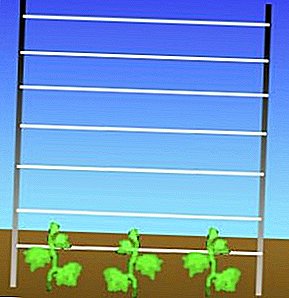 Horizontal. At the beginning and at the end of the beds set the rack (1-1.5 m tall). Between the tops of the uprights pull the wire or rope. At a distance of 50 cm below - another, parallel to the first.
Horizontal. At the beginning and at the end of the beds set the rack (1-1.5 m tall). Between the tops of the uprights pull the wire or rope. At a distance of 50 cm below - another, parallel to the first.Between them, every 50-70 cm, you can tie up vertical ropes.
- Vertical. At first, they do everything similarly to the previous method. Only instead of the second wire (bottom), on the top there are vertical, falling down ropes (according to the number of bushes in the garden). They tie each whip individually.
- Tapestry. Between racks of wire make a grid with a cell of 25-30 cm.

For "Mommy's pet" any of the above methods will do. It is only necessary to choose the optimal height of the tapestry. For this variety, the normal lower boundary of the grid (lower rope) is 30-35 cm from the ground, the top is 1 m.
Did you know? The main function of cucumber spikes is to help the plant get rid of excess fluid.
Top dressing
After the appearance of the first growth of the plant must be fed. They do this when the first 2 true leaflets grow. For spring feeding, ash can be used (50 g per 1 sq. M). Mullein or bird droppings will do. Litter insist in water for 1 week (1 part to 4 parts of water). The appearance of a characteristic odor indicates the readiness of the funds. The resulting concentrate is diluted with water (1:10) and watered cucumbers (0.5 l per 1 plant).
In the event that in the fall you could not fertilize, in addition to organic matter, you must also apply mineral fertilizer:
- potassium sulfate. 20 liters of water 40 g of fertilizer. Water the lash 1.5 liters of funds after the 3 leaf appears.After 3 weeks, repeat the procedure;
- nitrophoska. 30 g per 20 liters of water. Watering - after the appearance of 2 leaves (1.5 l per 1 plant);
- urea. In 6 liters of water dissolve 2 tbsp. fertilizer spoons. Spray the whip at the time of formation of the ovaries;
- ammofosk. Dig deep grooves (5-7 cm) along the whole row in the rows. Evenly distributed in 1 groove 2 tbsp. spoons of the drug. Then fill the grooves with earth, dig deep.
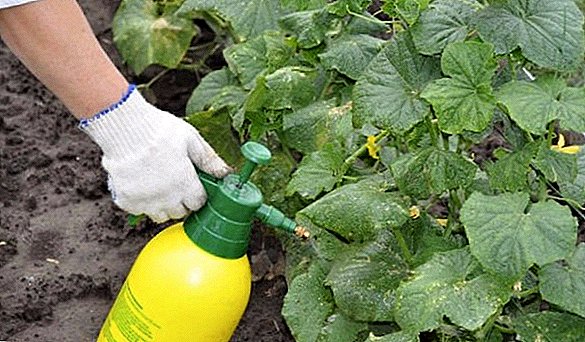 If the plants bear bad fruit, and the fruits look weak, have an uncharacteristic dull color, this means is applied to each root:
If the plants bear bad fruit, and the fruits look weak, have an uncharacteristic dull color, this means is applied to each root:
- ammonium nitrate - 1 tbsp. spoon;
- superphosphate - 1.5 tbsp. spoons;
- potassium nitrate - 0.5 tbsp. spoons;
- water - 1 bucket.
Learn how to feed cucumbers using yeast.
Well increase the yield of cucumbers and foliar feeding (spraying), for example, with a solution of superphosphate in warm water (2 tablespoons per 1 bucket of water). Or by such means:
- potassium permanganate - 0.5 g;
- boric acid - 1 tsp;
- water - 5 l.
Important! Urea cannot be used simultaneously with lime or superphosphate. Because of the chemical reactions that occur as a result of such a mixture, nitrogen goes from the fertilizer.
Pests, diseases and prevention
Although the hybrid has a rather developed resistance to diseases, it is still worth to say a few words about the most characteristic diseases and pests:
- mealy dew - pale spots on the back of the leaves. With the development of the disease, the spots darken and pass to the other side of the leaves. Against the disease, apply Oxyh (10 g per 5 liters of water). Spray the affected plants overnight, and repeat the procedure after 16–20 days. Also use the tool "Topaz", during the harvest period - colloidal sulfur, "Thiovit Jet", "Fitosporin-M";
- downy mildew - round spots of a pale yellow shade, later they darken and turn purple. Means "Topaz" (1 ampoule on 1 bucket of water). Spray overnight, repeat after 12 days. Used for the treatment and Bordeaux liquid, "oxy";
- alternarioz - the lower leaves are covered with bright ulcers that grow and cover the plant completely. At night, spray "Ridomil Gold" (50 g of product per 10 liters of water) every 10-12 days;
- anthracnose - longitudinal grooves-ulcers are formed on the stem, the fruits begin to rot. For spraying apply "oxy".




Of the parasites can be distinguished aphid and minera. Plants are sprayed twice with a 0.5% Fitoverma solution, with a frequency of 2 weeks.
We advise you to read about other common diseases and pests of cucumbers.
A few simple rules, compliance with which will help protect cucumbers from diseases:
- Avoid adding large amounts of nitrogen with fertilizers;
- when planting, observe the distance between the bushes in order to avoid air stagnation;
- contact the plant carefully - any scratch or wound on the plant opens the way for diseases;
- inspect the plants regularly for diseased fruits and foliage. If found, remove them immediately.
Harvesting and storage
Collect "Mamenkin favorite" as soon as cucumbers reach their marketability - 8-10 cm in length. During the rapid fruiting, it is more expedient to carry out the collection twice a day - in the morning and in the evening.
Did you know? Previously, in the villages, this method of storing cucumbers was popular: in a non-freezing winter, a stream with a good current was placed a barrel filled with cucumbers, with a weight to make them heavier. This method allowed fresh fruit to feast even with the onset of the next year.When harvesting, do not forget about some rules:
- Do not leave overripe fruit on the scourge, they prevent the formation of young ovaries. Sick, deformed fruits remove.
- The more often you harvest, the more small cucumbers appear, excellent for salting and pickling. If, however, reduce the frequency of collection, the fruits grow larger - salad.
- When collecting cucumbers, use a knife.
- Do not twist or try to break off the fruit.
- Do not twist or turn the whip, its position should remain unchanged.
 Increase the period of freshness of the fruit can be such ways:
Increase the period of freshness of the fruit can be such ways:
- Hermetically wrap in plastic bags and place in the refrigerator.
- Cucumbers put in a container vertically, tightly to each other, on the stem. At the bottom of the tank pour 2-3 cm of water and place it in the refrigerator. Water must be changed 1 time in 2 days.
Learn how to keep cucumbers fresh for the winter.
Possible problems and recommendations
When growing "Mama's pet" sometimes there may be some trouble:
- For growing seeds in the beds need a greater amount of planting material.
- Yellow leaves are often indicative of improper watering.
- Waterlogging of the soil contributes to poor aeration of the root system, which leads to disruption of metabolic processes in the plant.
- Improper fertilization can also lead to yellowing of the foliage.
- With calcium deficiency, the ovary may not form, and the fruits will not have a characteristic cucumber smell.
- Failure to follow the rules of crop rotation is another cause of yellow leaves.
- Sharp climatic changes lead to leaf fall.
- Foliage crumbling and incorrect application of fertilizers (violation of concentration).
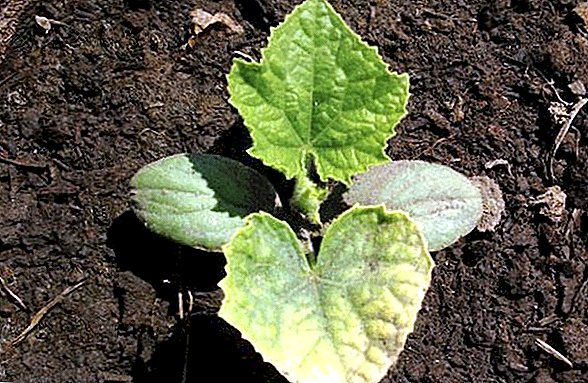
Important! It is impossible to plant plants in the neighboring beds that are pollinated by bees and self-pollinated. The fact is that some hybrids do not react at all to bees, while others, as a result of pollination, give birth to deformed fruits.
"Mama's favorite" - a variety with excellent taste, precociousness and also quite undemanding in the care. What is important for novice gardeners, it is resistant to diseases and adapted to the climatic conditions of most of the Eurasian continent. If you want to grow on your plot wonderful cucumbers, suitable for both salting and salad, choose this hybrid.


 Horizontal. At the beginning and at the end of the beds set the rack (1-1.5 m tall). Between the tops of the uprights pull the wire or rope. At a distance of 50 cm below - another, parallel to the first.
Horizontal. At the beginning and at the end of the beds set the rack (1-1.5 m tall). Between the tops of the uprights pull the wire or rope. At a distance of 50 cm below - another, parallel to the first.